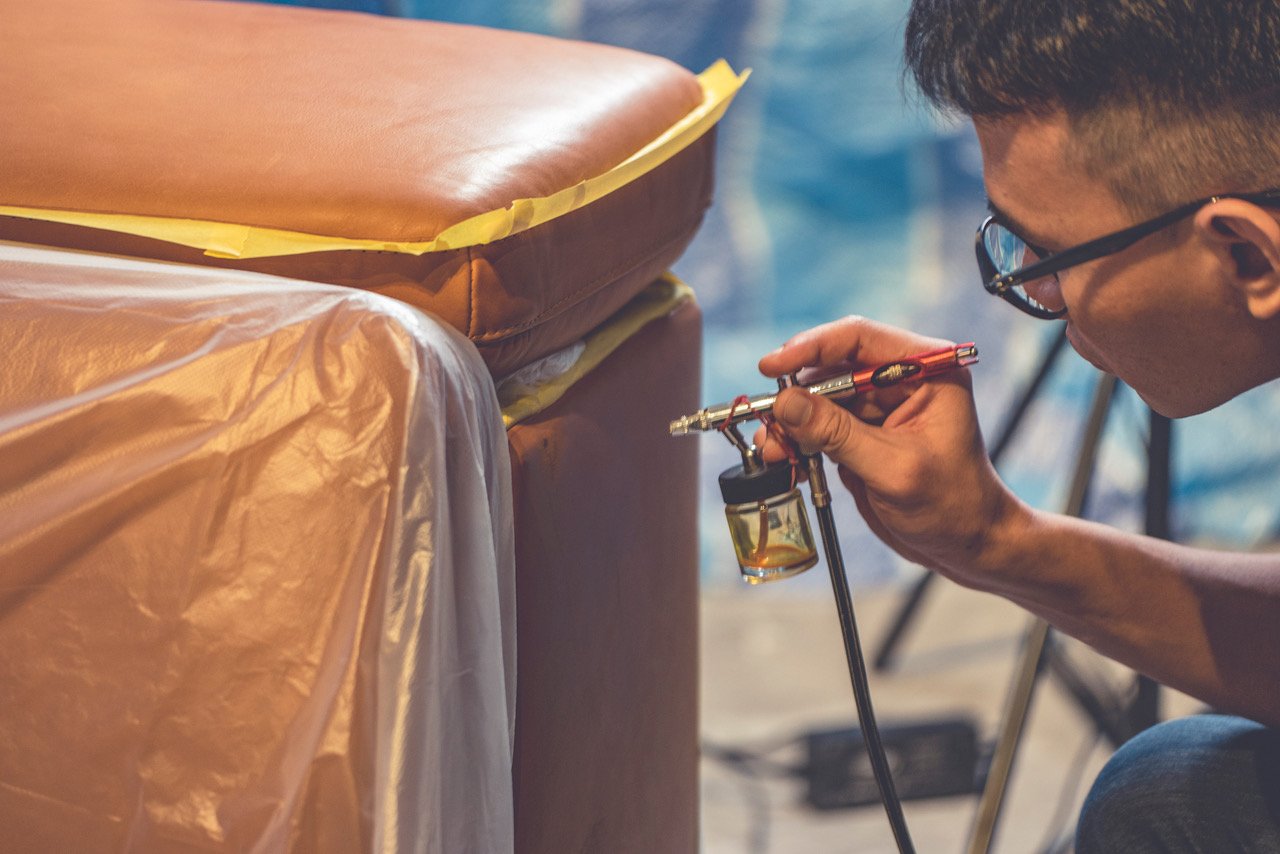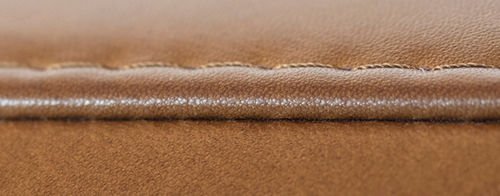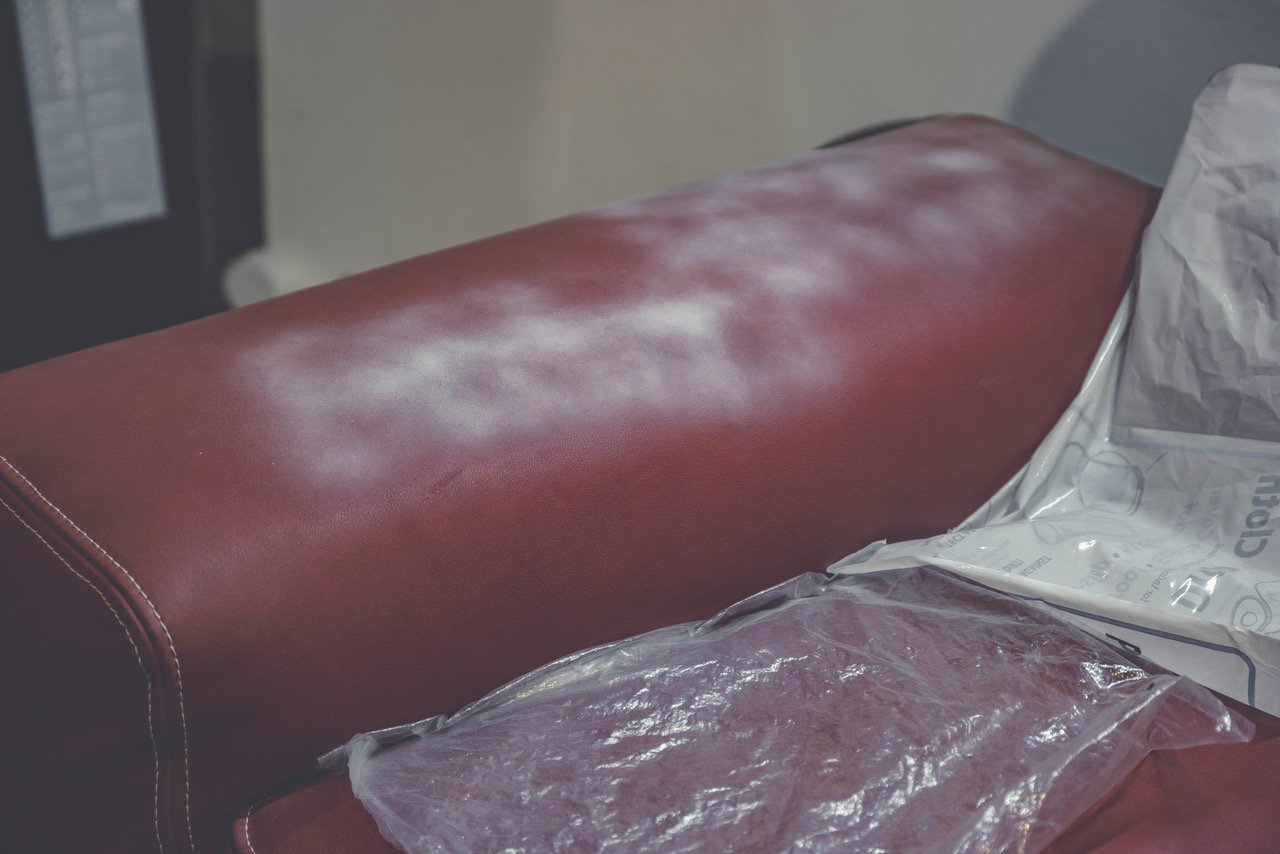
Aniline.
King of Leathers.
Only flawless hides, free from scars, injuries, and fire-brands, are selected to process into Aniline leather. This makes Aniline the most prized and expensive type of leather, reflecting its superior quality and status.
Leather Colouring Structure. Primer + Surface Colour Coat + Top Coat = Pigmented Top Grain. Without these layer, the finish is Aniline.
Aniline leather is renowned for its ability to exhibit the natural texture of the hide’s surface. This is because it lacks a pigmented surface colour layer, allowing the natural characteristics, including any imperfections, to remain visible. The absence of additional coatings not only showcases Aniline natural appearance but also provide it with a soft and warm feel to the touch.
Due to its stringent selection criteria for suitable hides, Tanners estimate less than 5% of delivered hides are deemed appropriate for Aniline. Consequently, Aniline leather is considered a top-grade leather, and when grain matching is employed, the final aniline products will have a price to match its status.
Water droplet on Porous Leather.
Water droplet sinks in almost immediately.
Picture Credit: Colourlock® International.
Water Test
Aniline is a porous leather. When a water droplet is rubbed onto it, it will penetrate and darken the surface.
This demonstrated Aniline’s high breathability, sensitive haptic and excellent comfort; Aniline breathes with our skins.
However, the trade-off means it is highly susceptible to water marks, grease stains as well as fading caused by sunlight.
Aniline is sought after for its warm, wax grip and low satin gloss. Pure Aniline, which lacks any surface finishing, is particularly valued for developing a patina over time. Aniline is used in furniture, handbags, shoes and clothing due to its natural look and feel. However, it is not suitable for car interiors, where ease of cleaning and maintenance are critical requirements.
Semi-Aniline.
Excellent Top Grain.
An ideal leather would combine the natural and soft qualities of Aniline with the durability and insensitivity of pigmented leather. However, achieving this perfect blend is not possible.
To create a natural, soft and warm leather with slight protection, tanners produce Semi-Aniline by applying a thin colour coat on Aniline leather. This allows natural grain pattern and hair pores to remain visible, ensuring the leather’s natural grain is preserved without buffing.
Semi-Aniline feels natural and soft despite having a thin layer of colour coat. As it is considered a high-quality pigmented leather, it is often mislabelled; pigmented leather is sometimes incorrectly referred to or sold as Semi-Aniline leather, misleading customers into thinking they are buying a higher-quality product. More will be discussed in Caveat Emptor
Semi-Aniline leather is commonly used for making furniture, jackets, and bags. Semi-Aniline furniture can be suitable households without children and pets due to its increased sensitivity compared to pigmented leather. Because of its delicate nature, Semi-Aniline leather is rarely found in cars.
Vintage Leather.
Robust Waxed Aniline.
A waxed Aniline is referred as Vintage leather while, a waxed Nubuck is called a Pull Up leather. The main difference between them is that patina development is not as fast or as pronounced with Pull Up Leather.
Vintage and Pull Up Leathers are made from high-quality, robust top grain leathers and are finished with oils and waxes to create a modern, used-look finish. Although there are some differences, they are mentioned together here as the use of these terms is becoming more interchangeable today.
Also known as oiled leather, these leathers have soft and scratch-sensitive finish, which allows them to develop vintage patina quickly. Colour variations and scratches are natural marking and not defect, so customers should understand this is a desired effect; otherwise, they may be disappointed.
Both of these oiled leathers, as they are sometimes called, boast a soft, warm and waxy texture, offering a cosy fell to the touch. They have more superior breathability compared to pigmented leather. However, it’s important to note while they are less sensitive to water than Aniline, they are still prone to liquid stains.
Pull Up Leather.
Robust Waxed Nubuck.
PU leather is often mistakenly thought as an abbreviation of “Pull Up”; their appearances are so similar that care and cleaning instructions are frequently and incorrectly mixed up. Hence, it is important to check which reference during buying process.
PU leather is sometimes confused as Pull Up Leather; PU stands for Polyurethane coating. It is incorrect for PU Leather to be sold as Pull Up Leather. Pull Up Leather is waxed top grain leather whereas PU Leather is split leather laminated with a polyurethane coating to resemble top grain.
Not only they will be the conversational piece of any home, well-maintained Vintage and Pull Up Leathers are known to last decades and are less sensitive to water than Aniline, Nubuck and Suede. They are commonly used in bag, belt, shoes and furniture.
Nubuck.
Excellent Tactile.
Caressing a Nubuck is akin to stroking glazing cattle; it offers exceptional breathability and its softness makes it a tactile delight.
Nubuck features a fine and recognisable pile, adding to its unique and luxurious.
With its smooth and specially sanded top grain, Nubuck unveils a velvety surface where the natural grain and hair pores remain fully visible. Similar to Aniline, only flawless hides devoid of visible scars are chosen for Nubuck, cementing its status as premium leather.
Sensitivity
Like Aniline, Nubuck is a porous leather. The rough-sanding on its top grain side leaves a warm and soft surface.
However, this enhanced sensitivity comes with a trade-off; Nubuck is more susceptible to water marks, grease stains and fading caused by sunlight.
Nubuck commonly comes from cow hides and calf skins, though goat, lamb and deer skins are also used. It is utilised for furniture, handbags, clothing and shoes due to its soft and luxurious texture. However, It is very rare to find Nubuck in automotive application.
Suede.
Excellent Breathability.
In contrast to soft and smooth napping of Nubuck, Suede has a significantly rougher tactile feel.
Suede is often mistaken with Alcantara; however, Alcantara is a type of fabric that resembles the look and feel of Suede.
Suede refers to 2 types of leather; Split leather with both sides having a velour surface and the flesh side of a top grain leather (reverse side). The most common type of Suede is flesh split.
In essence, there are 3 types of Suede: reverse side of top grain (highest quality), drop split and bottom split. Most Suede is chrome tanned, which has twice the strength of vegetable tanned leather, yet weighs less. Suede is most commonly used on sneakers and gloves. It is also used in furniture and handbags.
Sensitivity
Suede is highly porous, offering strong breathability as sweat can pass through quickly. This makes Suede a popular choice for sneakers and working gloves.
The irregularities in Suede are not visible as its fibres are often pressed down and pre-treated.
Conclusion
Conclusion
We now understand that Aniline, Nubuck and Suede – the reverse side of top grain variant – are derived from top grain leathers. We’ve also learned how Vintage & Pull Up leathers are sub variants of Aniline and Nubuck, and lastly, why Aniline is such a sought-after, prized leather.
In addition, it is important to acknowledge that Semi-Aniline, despite its thin surface coating of colour, should be categorised as Porous leather to prevent any misunderstanding or misrepresentation when compared to Pigmented Top Grain.
In next chapter, we will learn about 2 other types of genuine leathers: Pigmented Top Grain and Corrected Grain, forming the Non-Porous group. Combined with Porous group, they complete the genuine leathers line-up. Understanding these terms will provide a clear meaning of the types of leather finishes and help to avoid confusion.
DID YOU KNOW…
Females hides have a denser fibre and a finer grain structure compared to male hides. However, the stability of this structure diminishes with each successive pregnancy. Additionally, stretch marks that develop during pregnancy can impact the quality of the hide.
For males, the frequency of mating can influence the quality of their hides. Interestingly, castrated oxen often have a finer skin structure.












